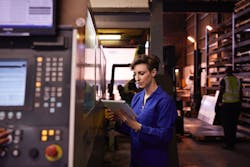Manufacturers on a journey to make production processes “smarter” typically start by aggregating data from around the plant with the ultimate goal of optimizing systems and operations. Of course, gathering data from different systems—be it sensors, a historian, quality control, or a manufacturing execution system (MES)—is straight forward enough. But all that information lives in different data schemas, which means different structures for organizing and classifying that data, which also means someone has to knit it all together to make sense of it. That’s the hard part.
Sight Machine, a provider of manufacturing analytics software, has been working to solve this problem. In 2018, the company introduced a cloud-based platform that enabled centralized management of multi-factory Industrial Internet of Things (IIoT) data using artificial intelligence (AI) and machine learning algorithms to work with structured and unstructured data. Earlier this year, the company launched its Manufacturing Data Platform (MDP) which provides scalable analytics to compare interdependencies between production lines, different facilities, and the supply chain.
Now, with this month’s announcement of Dynamic Recipes, Sight Machine has added a way to continuously and automatically update machine settings to produce optimal performance based on a combination of conditions related to raw materials, the environment, and output—such as grades of paper, for example.
“Operators know what to do to optimize processes based on their experience, and [they] form a judgement of what adjustments to make in order to set everything up to have minimal quality problems and to predict efficiency,” said Jon Sobel, co-founder and CEO of Sight Machine. “But there are variations in the conditions of the plant and in raw materials.” When faced with variations, it requires deep domain expertise to make adjustments. Dynamic Recipes can automatically make the adjustments based on a range of parameters.
See it Live at PACK EXPO Connects Nov. 9-13: Nita 4.0 – The future of CONNECTED labeling is now! by Nita Labeling Systems. Preview the Showroom Here.
“We announced the ability to flexibly set up the right recipe for production conditions based on what you determine the conditions to be,” Sobel said. “And every time you do this it goes back into the underlying data used to generate the rules, so it is constantly getting better.”
To that end, Sight Machine has also introduced a new Productivity KPI Model that lets manufacturers optimize production according to their own preferred metrics. These metrics vary widely among companies, but typically include quality, uptime, and throughput. According to the company, Productivity KPIs give manufacturers consistent, apples-to-apples metrics to track productivity of all lines and plants across the enterprise. In other words, manufacturers are able to track the performance of all their machines, lines, and plants using a uniform metric that is based on how well the asset is performing versus its maximum potential performance.
“The second part of the announcement is super important,” said Sudhir Arni, Sight Machine’s senior vice president of business outcomes. “We launched a KPI model that makes it easy to set up a formula for any KPI…If you make any change to the data table it is reflected in the KPI, which makes it flexible and scalable based on what works best in the plant.”
Dynamic Recipes optimize for any combination of targeted Productivity KPIs, such as minimizing cost and maximizing throughput. The prescribed recommendations automatically adjust as conditions change, and recipes automatically improve to reflect new top-performing production runs.
Operators in the control room or on the plant floor interact with the Dynamic Recipes using a new application called Operator Co-Pilot. Within Co-Pilot, they input current conditions (e.g. raw materials, desired output grade, humidity), make any adjustments to the targeted KPIs, and receive prescribed machine settings.
Sight Machine can deliver these capabilities in real-world manufacturing environments due to the platform’s unique data modeling foundation which takes the dozens of incompatible data types generated by factory equipment and manufacturing software and generates a digital representation of the entire production process, including processes, production lines, downtime and defects. The platform also continuously models and analyzes all production data in real time, allowing manufacturers to monitor and improve current performance instead of only analyzing past performance.
And while previous generations of the Sight Machine platform have been used primarily to help manufacturers understand how their factories are doing and analyze how to improve them using descriptive analytics, the new enhancements go beyond descriptive analytics to provide prescriptive analytics, proactively recommending the settings and processes needed to achieve the highest productivity under ever-changing conditions.
Related content:
New Platforms Aim to Scale IIoT Analytics
Sight Machine Launches Data-Powered Continuous Improvement for Vertical Segments
Leaders relevant to this article:

